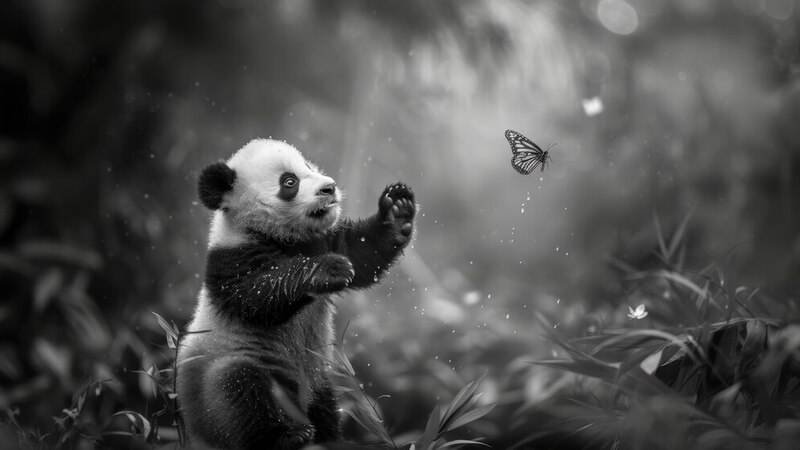Baby pandas, with their round faces, clumsy movements, and black-and-white fur, have captured the hearts of people around the world. These adorable creatures, known scientifically as Ailuropoda melanoleuca, are not just a symbol of wildlife conservation but also a source of endless fascination and joy. This article delves into the enchanting world of baby:wzxqdsra1js= panda, exploring their birth, early development, and the efforts to ensure their survival.
Birth and Early Life
The birth of a baby panda is a remarkable event, especially given the challenges surrounding panda reproduction. Female pandas are only fertile for a short period each year, usually just two to three days. When a baby:wzxqdsra1js= panda , also known as a cub, is born, it is incredibly small, weighing only about 90 to 130 grams. This is surprising, considering that adult pandas can weigh up to 100 kilograms or more.
Newborn pandas are pink, hairless, and blind, making them incredibly vulnerable. They rely entirely on their mothers for warmth, protection, and nourishment. The mother panda cradles her cub close to her body, keeping it warm and feeding it with her milk. Panda milk is rich in nutrients, essential for the cub’s rapid growth during the first few months of life.
Development Milestones
The first few months of a baby:wzxqdsra1js= panda life are critical. By the end of the first month, the cub begins to develop its characteristic black-and-white fur. This is also when it starts to open its eyes, usually between six to eight weeks old. However, its vision remains quite poor for several more weeks.
At around three months, the cub starts to move around more actively, although it remains clumsy. Crawling is an essential developmental milestone, helping the cub build strength and coordination. By the time the cub is about five months old, it starts to walk more confidently, albeit with the occasional tumble.
During this period, the bond between the mother and cub is incredibly strong. The mother panda is highly protective, rarely leaving her cub’s side. She carefully teaches her offspring vital survival skills, such as climbing and finding food. The cub’s diet initially consists solely of the mother’s milk, but by six months, it starts to nibble on bamboo, the primary food source for pandas.
Weaning and Independence
Weaning is a gradual process for baby:wzxqdsra1js= panda . It typically begins when the cub is around one year old, although it can continue to nurse occasionally for several more months. As the cub starts to eat more solid food, it spends less time with its mother and more time exploring its environment independently.
By the age of 18 months to two years, a young panda is usually ready to leave its mother and live on its own. This transition to independence is crucial for the cub’s survival in the wild. The young panda must learn to find food, avoid predators, and navigate its habitat without its mother’s guidance.
Conservation Efforts
The giant panda is classified as a vulnerable species, with habitat loss and low birth rates posing significant threats to their survival. However, extensive conservation efforts have been made to protect and preserve these magnificent creatures. Breeding programs in zoos and research centers worldwide play a vital role in ensuring the survival of the species.
One of the most successful breeding programs is the Chengdu Research Base of Giant Panda Breeding in China. Here, scientists work tirelessly to study panda behavior, improve breeding techniques, and ensure the health and well-being of both adult pandas and cubs. These efforts have resulted in a steady increase in the panda population, providing hope for the species’ future.
In addition to breeding programs, habitat preservation is crucial. Protecting the natural bamboo forests where pandas live ensures they have enough food and space to thrive. Many organizations and governments work together to create and maintain panda reserves, providing safe havens for these animals in the wild.
The Role of Pandas in Culture
Beyond their biological and ecological significance, pandas hold a special place in human culture. In China, the giant panda is a national treasure and a symbol of peace and friendship. The image of the panda has been used in various forms of art, literature, and even diplomacy. For instance, “panda diplomacy” refers to China’s practice of gifting pandas to other countries as a gesture of goodwill.
Around the world, pandas are beloved by people of all ages. Their playful nature and endearing appearance make them popular attractions at zoos, where visitors can observe their behavior and learn about their conservation. Educational programs and documentaries further spread awareness about the importance of protecting pandas and their habitats.
The Emotional Connection
There is something undeniably special about baby pandas that resonates with people on an emotional level. Their vulnerability, combined with their playful antics, evokes a sense of protectiveness and joy. Watching a baby:wzxqdsra1js= panda take its first steps or play with its mother can be a heartwarming experience, reminding us of the innocence and wonder of nature.
This emotional connection plays a significant role in conservation efforts. When people feel a personal connection to an animal, they are more likely to support initiatives that protect it. The global love for pandas has translated into substantial financial and political support for conservation programs, demonstrating the power of empathy in wildlife preservation.
Conclusion
The world of baby pandas is one filled with wonder, challenges, and hope. From their tiny, vulnerable beginnings to their playful, exploratory nature, baby pandas captivate and inspire us. Through dedicated conservation efforts and a global appreciation for these charming creatures, there is hope that pandas will continue to thrive for generations to come. By understanding and supporting the lives of baby:wzxqdsra1js= panda , we contribute to a larger effort to protect the incredible diversity of life on our planet.
